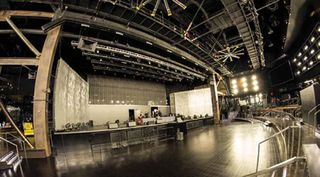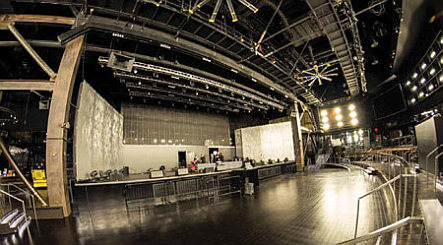On the Las Vegas strip, deep inside the SLS Hotel and Casino is the Foundry, a new state-of-the-art concert venue. Its odd but impressive layout—three stories tall, far wider than deep, with two of the three main bars flanking the spacious stage at a considerable distance—makes for challenging sound reinforcement.

Two Danley SH-96HOs cover main stereo, featuring 90-degree dispersion with complete phase coherence within that band, thus delivering even coverage for the majority of listeners. SLS hired JR Sound Company to design a system that would place the Foundry demonstrably above Las Vegas’ burgeoning contemporary concert scene. Their plan sidestepped appeals from promoters and industry insiders to go with a line array solution; they felt such a setup would be too uneven, with too much comb filtering. Instead, pointsource Danley SH-96HO mains, SH-95HO and SH-95 fills, SM-80 on-stage monitors, and TH-118 subwoofers bathe the Foundry in coherent, undistorted, transparent audio at sound pressure levels to silence all skeptics.
“Although we mainly do design and consulting these days, Mark and I are both live sound engineers by training and passion, and so we were excited to take on the project and to do it right,” said James Rush, co-owner of JR Sound Company, speaking on behalf of the company’s other co-owner, Mark Dudzik.
“There was a lot of pressure to go with a line array system, if for no other reason than everyone knows what they’re getting,” said Dudzik. “But we already had a lot of experience with Danley’s point-source systems, and we knew they sound way better than even the best, most expensive line arrays. We took the stance that, as engineers, we would much rather mix on a Danley system. To prove our point, we arranged a shootout between our company’s Danley SH-96s and the leading line array choices. Hearing is believing, and SLS had the confidence to move forward with the better sound of a Danley system.”
The SLS system consists of two Danley SH-96HOs for main stereo coverage. They have 90-degree dispersion with complete phase coherence within that band and thus deliver even coverage and spatial imaging to the majority of listeners. Two smaller Danley SH-95HOs provide out-fill to cover the flanking bars on either side of the stage. Four Danley SH-95s provide front-fill.
“With line array systems, the resultant sound, like a house of cards, depends on all of the components and their DSP. If you take out components, the whole thing becomes unbalanced,” Dudzik said. “In contrast, when we take out any of the fill speakers in the Foundry’s Danley system, the system still sounds great. And when we put them back in, it’s almost like they reinforce the stereo image. There’s no comb filtering and all of the patterns work together. It’s really stable.”
Three Danley TH-118 subwoofers hang under each main cluster (six total), and musicians on stage have 12 bi-amped Danley SM-80 monitors. “I got into this business as a monitor engineer, and I can say that the SM-80s sound great,” said Rush. “And, amazingly, no one ever asks for more volume when they’re using Danley monitors. The clarity and fidelity cuts through, and their coaxial design does good things for the on- and off-axis response.”
Two Midas M32 consoles (one for FOH and one for monitors) with a Midas DL32 stage box form the interface for the sounds picked up by a Shure live microphone package. Output from the Midas system feeds a Danley DNA SC48 DSP unit via a 96kHz Dante network with backup analog outputs for the mains, fills, and subs. A beefy rack of Danley DNA 20k4 Pro and DNA 10k4 Pro amplifiers power the complete system at four channels per unit. Onboard DSP on a subset of the amps provides loudspeaker conditioning for the monitor system.













